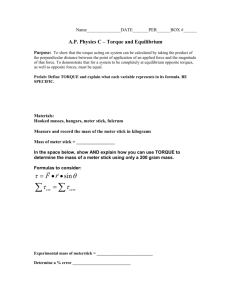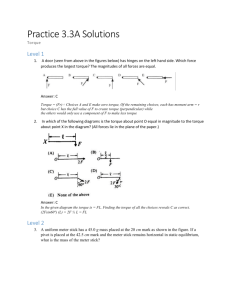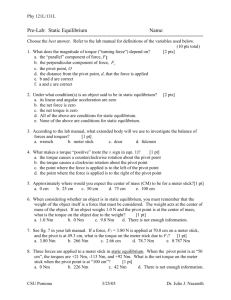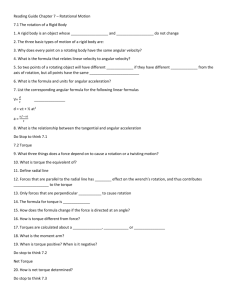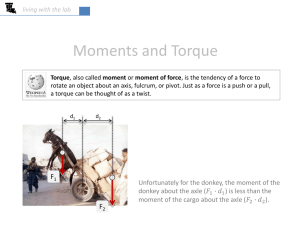Static Equilibrium
advertisement
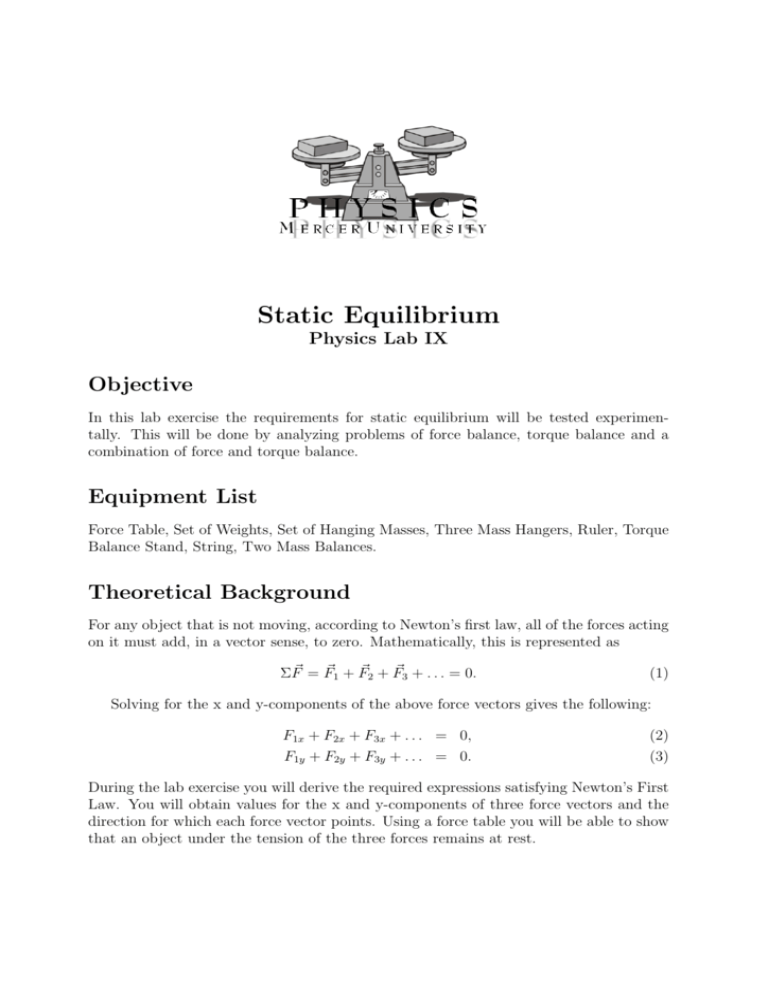
Static Equilibrium Physics Lab IX Objective In this lab exercise the requirements for static equilibrium will be tested experimentally. This will be done by analyzing problems of force balance, torque balance and a combination of force and torque balance. Equipment List Force Table, Set of Weights, Set of Hanging Masses, Three Mass Hangers, Ruler, Torque Balance Stand, String, Two Mass Balances. Theoretical Background For any object that is not moving, according to Newton’s first law, all of the forces acting on it must add, in a vector sense, to zero. Mathematically, this is represented as ΣF~ = F~1 + F~2 + F~3 + . . . = 0. (1) Solving for the x and y-components of the above force vectors gives the following: F1x + F2x + F3x + . . . = 0, F1y + F2y + F3y + . . . = 0. (2) (3) During the lab exercise you will derive the required expressions satisfying Newton’s First Law. You will obtain values for the x and y-components of three force vectors and the direction for which each force vector points. Using a force table you will be able to show that an object under the tension of the three forces remains at rest. 2 Static Equilibrium An object begins to rotate about a fixed axis by the application of a torque, just as an object begins to traverse a linear path through the application of a force. Torque is the product of an applied force F acting on an object and distance r⊥ from which the force acts away from the rotation point. Here r⊥ is a distance perpendicular to the direction of the applied force. Figure 1 illustrates this idea. Figure 1: Illustration of Torque Figure 1 shows the force of gravity F acting on an object of mass m located a distance r away from the fulcrum. The wooden beam experiences a net torque and begins to rotate clockwise about the fulcrum. Mathematically, torque is expressed as the vector cross product of the force F~ and the distance ~r ~τ = ~r × F~ . (4) The magnitude of torque τ is given for a value of r perpendicular to the applied force. τ = F r⊥ sin(θ) = F r⊥ (5) The requirement for an object to be stationary while external torques act on it is the sum of the all external torques acting on the object must be zero, Στ = τ1 + τ2 + τ3 + . . . = 0. (6) It will not be necessary to determine the components of τ . The direction of the applied torque will be determined by “type” of rotation, either positive or negative. Distances to the left of the fulcrum provide negative rotations, while distances to the right give positive rotations. Forces acting “upward” (i.e. in the positive y-direction) are positive, while forces acting “downward” (i.e. in the negative y-direction) are negative. The combination of a positive force and a positive distance, or a negative force and a negative distance, yields a rotation in the counterclockwise direction, which results in a positive Static Equilibrium 3 rotation. A positive force and a negative distance, or a negative force and a positive distance, yields a clockwise rotation which results in a negative rotation. Using these rules, the necessary force and/or distance needed to balance the torques acting on an object can be calculated. The combination of force balance and torque balance on an object means the object is in Static Equilibrium. These conditions of static equilibrium will be tested experimentally. Procedure and Data Analysis Force Balance In this exercise, the forces acting on a ring on a force table will be broken into components. The force, both magnitude and direction, necessary to balance the ring will be calculated and tested experimentally. Show your calculations on a separate piece of paper. 1. Measure the mass of one slotted 50 gram disk. Measure the mass of one mass hanger. Add the mass of the disk to the mass of the hanger and record the sum on your data table as m1 . Repeat this process for a second 50 gram disk and mass hanger. Record the sum as m2 . Be sure to convert mass units to kilograms!!! The weight of these masses account for two of the three which act to balance forces acting on the ring. Calculate the x and y-components of these force vectors if m1 is placed at an angle of 40◦ and m2 is at an angle of 120◦ . Each member of lab group should perform this calculation and then compare results. When a consensus has been reached, record the calculated results on your data sheet. 2. Use Equations 2 and 3 to calculate the x and y-components of the third force vector needed to balance the forces acting on the ring. F1 cos(θ1 ) + F2 cos(θ2 ) + F3 cos(θ3 ) + . . . = F1x + F2x + F3x + . . . = 0, F1 sin(θ1 ) + F2 sin(θ2 ) + F3 sin(θ3 ) + . . . = F1y + F2y + F3y + . . . = 0. (7) (8) The lab instructor will do an example of how this calculation is performed at the beginning of the lab period. Figure 2 illustrates the coordinate system imposed upon the force table. Figure 3 shows the components on the force table for this situation. 3. Use the x and y-components to calculate the magnitude and direction of the third force needed to balance the other two using the equations below. Note: Be careful when using the arctangent. It may be necessary to add 180◦ to the result to get the result into the correct quadrant. q F3x 2 + F3y 2 ¶ µ F3y θ3 = tan−1 F3x F3 = 4. Calculate the mass m3 required for the balancing force F3 . (9) (10) 4 Static Equilibrium Figure 2: Coordinate System for Force Table Figure 3: Graphical Representation of Force Balance 5. Place the masses m1 , m2 and m3 on the force table at the angles θ1 , θ2 and θ3 respectively. When the masses are in the correct positions, remove the pin holding the ring in place. If the forces are balanced, the ring will remain in place, moving slightly off center. If the ring does not remain in place, recheck your calculations. 6. Repeat steps 1-4 to find m4 and θ4 , with each member of your lab group choosing one of the cases listed in Table 1. Record the Case number in the appropriate box on your data table. Case # #1 #2 #3 #4 m1 , θ 1 0.100 kg , 20◦ 0.200 kg , 20◦ 0.100 kg , 10◦ 0.150 kg, 90◦ m2 , θ 2 0.200 kg , 90◦ 0.150 kg , 70◦ 0.150 kg , 70◦ 0.200 kg, 130◦ m3 , θ3 0.150 kg , 120◦ 0.200 kg , 130◦ 0.100 kg , 130◦ 0.150 kg, 70◦ Table 1 Cases for Force Balance Static Equilibrium 5 Torque Balance In this exercise, the torque due to a system of weights placed along a meter stick will be calculated and tested with the laboratory equipment. Show your calculations for each case on a separate piece of paper. 1. Calculate the torque of the meter stick due to a mass of 0.010 kg placed 0.40 m from the right of the center. Notice that the force points down and is located to the right of the pivot point demonstrating clockwise rotation, i.e. negative rotation. Each person in the group should perform these calculations. 2. Use the following equation to calculate the torque necessary to balance the torque above. m1 gr1 + m2 gr2 + m3 gr3 + . . . = τ1 + τ2 + τ3 + . . . = 0. (11) If a mass of 0.020 kg provides the force to balance this torque, calculate the distance at which the mass should be placed. The lab instructor will provide an example of how to calculate this force or distance to provide balance. 3. Cut three pieces of string all the same length. Tie a loop with the string pieces and place the loop onto the hook of the mass hangers. 4. Using the string looped mass hangers set each mass at the appropriate distance along the meter stick and determine experimentally whether or not the calculated distance for the 0.020 kg mass provides the balancing torque. 5. Repeat this process with each member of your lab group choosing one of the cases in Table 2. Note that a positive distance indicates a mass placement from the right of the center, while a negative distance indicates a mass placement from the left of the center. Record the Case number in the appropriate box on your data table. Case # #1 #2 #3 #4 m1 , r1 0.025 kg , +0.20 m 0.025 kg , 0.30 m 0.025 kg , 0.20 m 0.030 kg , 0.30 m m2 , r2 0.030 kg , +0.40 m 0.030 kg, -0.20 m 0.025kg , -0.30 m ? , -0.10 m m3 , r3 ? , -0.20 m 0.015 kg , ? m 0.010 kg , ? m 0.015 kg , -0.20 m Table 2 Cases for Torque Balance 6 Static Equilibrium Force and Torque Balance In this exercise, both force and torque balance will be applied to determine the normal force supplied to the ends of a meter stick supported by mass scales. Slotted weight will be placed at specific locations along the meter stick. Theoretical calculation values of the balancing force will be compared to experimental results. 1. Use one of the mass balances at your station to measure the mass of the meter stick, mS . Record this value on your data table. 2. Position the balances so that one is at each end of the meter stick. The meter stick should be placed just on the edge of each balance tray. 3. Use the force and torque balance equations to calculate the normal force supplied by each mass scale NL and NR , when a 100 g mass is placed 20 cm from the left end of the meter stick. Each person in your lab group should perform this calculation. Compare the results of your calculations with each other. 4. Place a 100 g mass disk 20 cm away from the left mass balance and record the mass readings indicated on each balances as the Experimental Values for the normal forces NL and NR on your data table. 5. Calculate the percent difference between the theoretical normal forces NL and NR and the experimental normal forces NL and NR . Record this percent difference value on your data sheet. 6. Repeat this process of calculating and then measuring the normal forces supplied by each mass scale using the mass and position values listed in Table 3. Each member of your lab group should choose one of the cases. In the table, the r values are measured with respect to the left side of the meter stick. Record the Case number in the appropriate box on your data table. Case # #1 #2 #3 #4 m1 , r 1 0.020 kg , 0.20 0.020 kg , 0.30 0.020 kg , 0.40 0.030 kg , 0.60 m m m m m2 , r2 0.030 kg , 0.40 m 0.030 kg, 0.80 m 0.020 kg , 0.60 m 0.020 kg, 0.20 m Table 3 Cases for Force and Torque Balance 7. Determine the uncertainty and smallest measured value of the mass, position and normal force measurements. For the uncertainty of the normal force measurements, divide the smallest measured normal force value by 9800m/s2 to obtain a value for the Normal “Force” in grams. Determine the normal force uncertainty from the mass scale. Calculate the percent uncertainty in each measurement using following equation: U ncertainty . (12) % uncertainty = 100 × Smallest M easured V alue 8. Record the largest percent uncertainty in the experiment. Static Equilibrium 7 Selected Questions 1. Can a body be in equilibrium if only one external force acts on it? Why or why not? 2. Can a body be in equilibrium if it is in motion? Why or why not? 3. Give an example in which the net torque acting on an object is zero while the net force is nonzero. 4. Give an example in which the net force acting on an object is zero while the net torque is nonzero.

